The carnivorous bear
Necrophagous and skilful predators, bears eat meat whenever they can
With the rains in April and first warm days in May, nature wakes from its winter torpor. The vegetation starts growing again, flowers bloom and many herbivores, including red and roe deer, wild boar and chamois, give birth.
At dusk, bears make their appearance in the clearings at the bottom of the valley in search of fresh vegetation, but that’s not all. A bear is quietly grazing downwind, browsing on leaves and shoots. Hidden in the tall grass no more than 150 metres from the bear, an alert doe concentrates on the potential predator. As soon as the wind veers in its favour, the bear stops, sniffs the air and rises up a little on its hind legs. It starts moving again like a bloodhound in search of its prey. It zigzags with its nose to the ground, sniffs the air, then retraces its steps again and again. The distance between the doe and the bear gets shorter and shorter. After about twenty minutes, when the bear is just a few dozen metres away, the doe leaps sideways, but does not flee. Then surprisingly, she starts jumping about in all directions in front of the predator. Drawing attention to herself would seem suicidal or desperate. The bear ignores the doe and goes back to sniffing determinedly in the direction the doe sprung out from. When it reaches its target, the bear plunges its head down into the grass, then walks away into the woods, clutching in its jaws the inert corpse of a fawn just a few weeks old. So this is what the doe wanted to protect: her newborn infant.
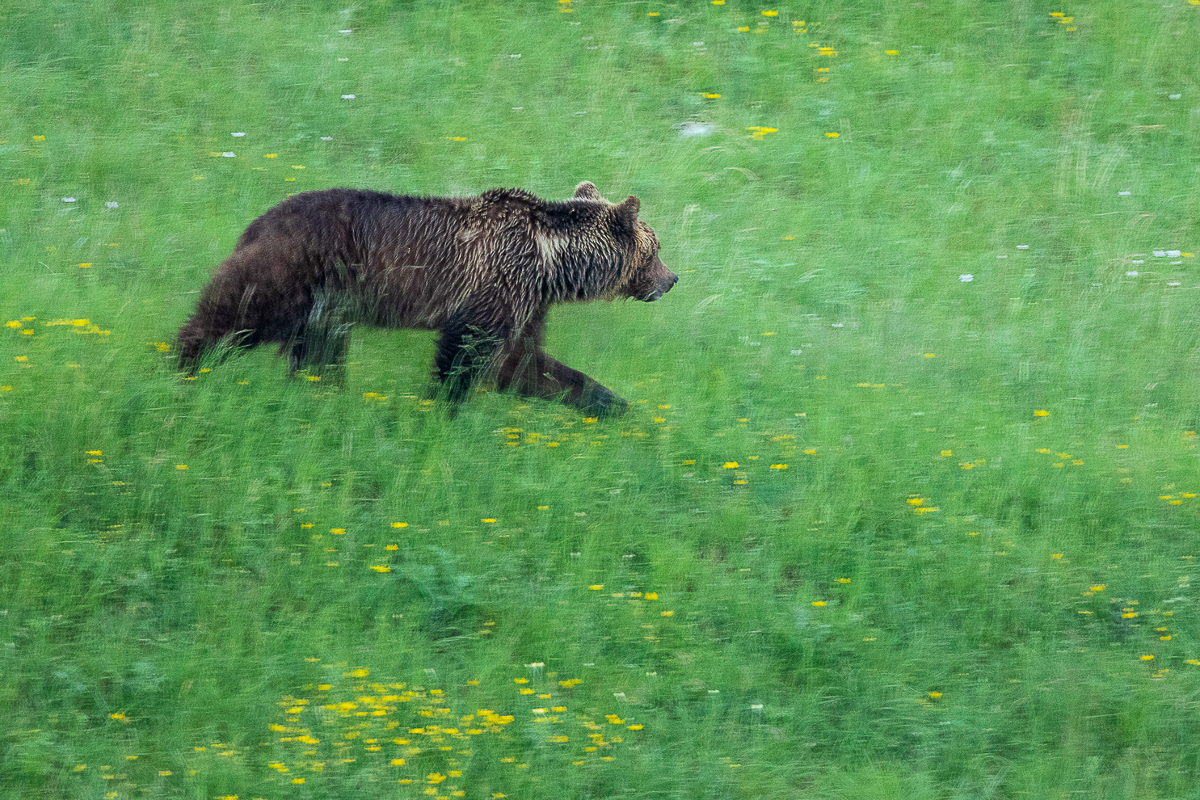
A bear in search of food crosses a spring pasture, using its sense of smell to pick up various scents. These are the situations when a bear has the greatest possibility of finding and killing a red or roe deer fawn.
Marsican bears are able to eat meat in all seasons and more than 90% of the energy assimilated through this resource comes mainly from ungulates, both wild (red and roe deer and wild boar) and domestic (cows, sheep, goats and horses).
But when the opportunity arises, bears may also feed on hares, dormice, squirrels and voles. In the 1970s, bears rarely ate meat (only 2% of excrement) and exclusively of domestic ungulates (sheep and goats). However, since the 1980s, following reintroduction of red and roe deer to the central Apennines, Marsican bears eat meat ever more frequently. Among the various species bears prey on, red deer appear most often in their diet. The red deer is the most widespread and numerous wild species in the Park and also the most vulnerable, especially in certain seasons.
Male bears generally consume almost twice as much meat as females, in line with their different life strategies. A female needs to accumulate mainly fat to carry a pregnancy to term, whereas for males, having a more powerful muscle mass enables them to compete in strength with other males. It is also true that males move around in much larger territories and are therefore more likely to come across available carcasses.
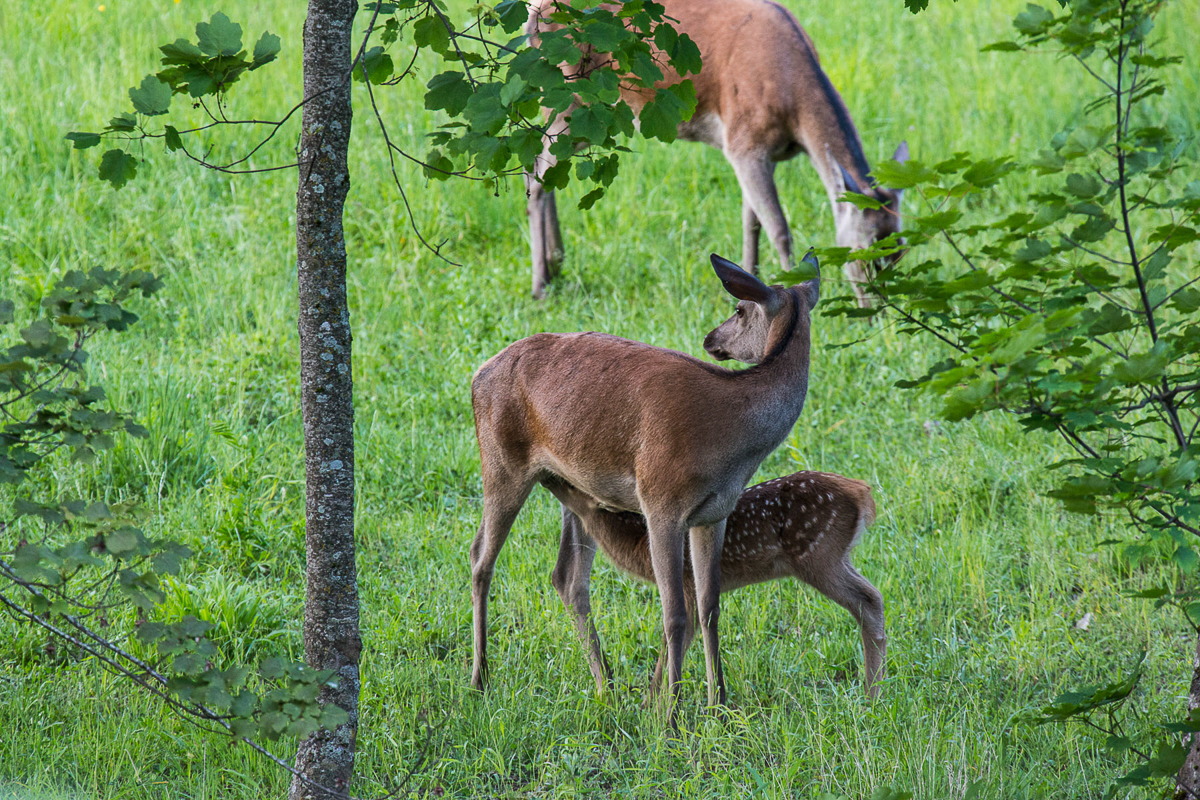
A red deer hind suckles her fawn, just a few days old. Deer give birth in the spring and the hinds must be particularly vigilant to protect their young from predators.
Consumption of wild ungulates peaks between April and June, during the first few months after the bears leave their den. Before the snow has completely melted, the bears go in search of animals that have died during the winter, been buried by avalanches or preyed on by wolves. A bear can sniff out the remains of a dead deer, even after dozens of days, especially if well preserved under snow. But during these months, the bears mainly prey on newborn deer and wild boar. Bears locate their prey by following the scent of the young or its mother, or by bursting into the herds in an attempt to flush out the mothers and make them flee so they can then locate the fawns.
As the season progresses, the young wild animals become less and less vulnerable, but sheep, goats, cows and horses make their appearance in the pastures, even high up in the mountains, and from July to September, these become the main source of animal protein for the bears. From October onwards, meat consumption drops to an annual low and bears eat almost exclusively wild prey. This season coincides with the mating season and the stags, worn out by fasting and exhausting fights to defend their harem of females, fall easy prey to bears and wolves. Many also die of starvation.
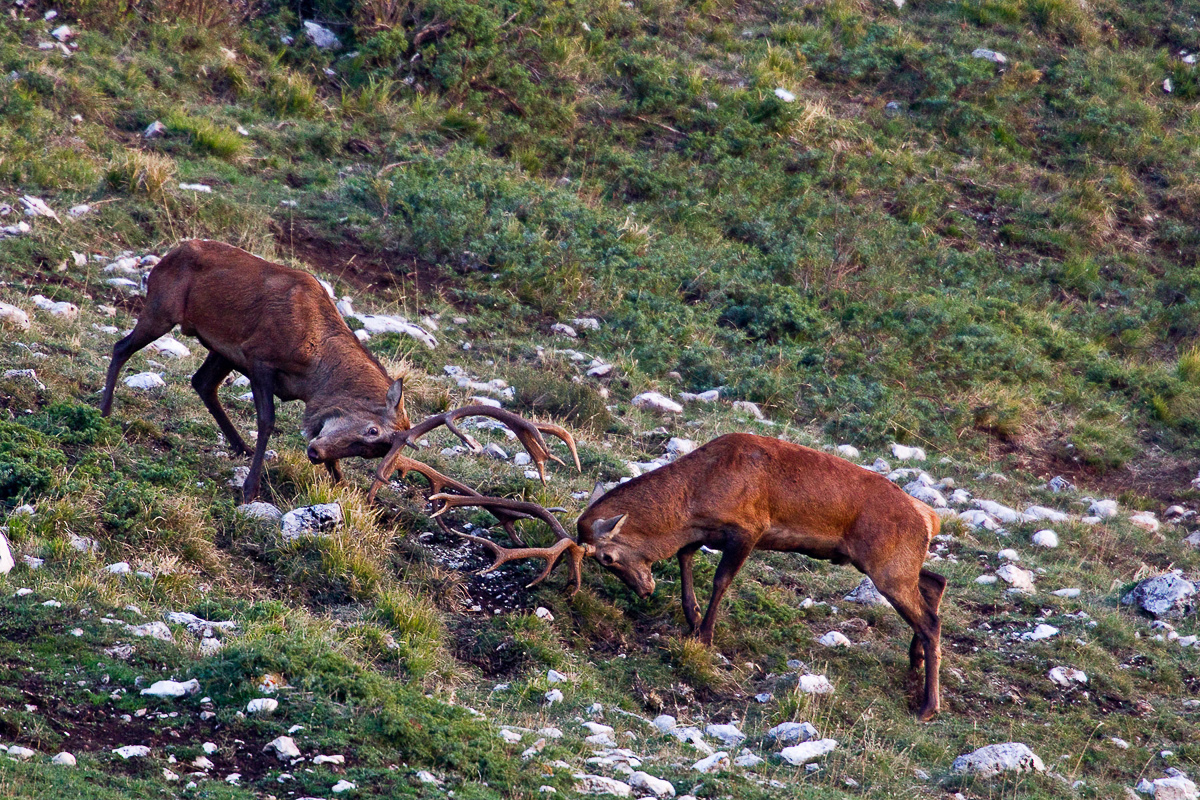
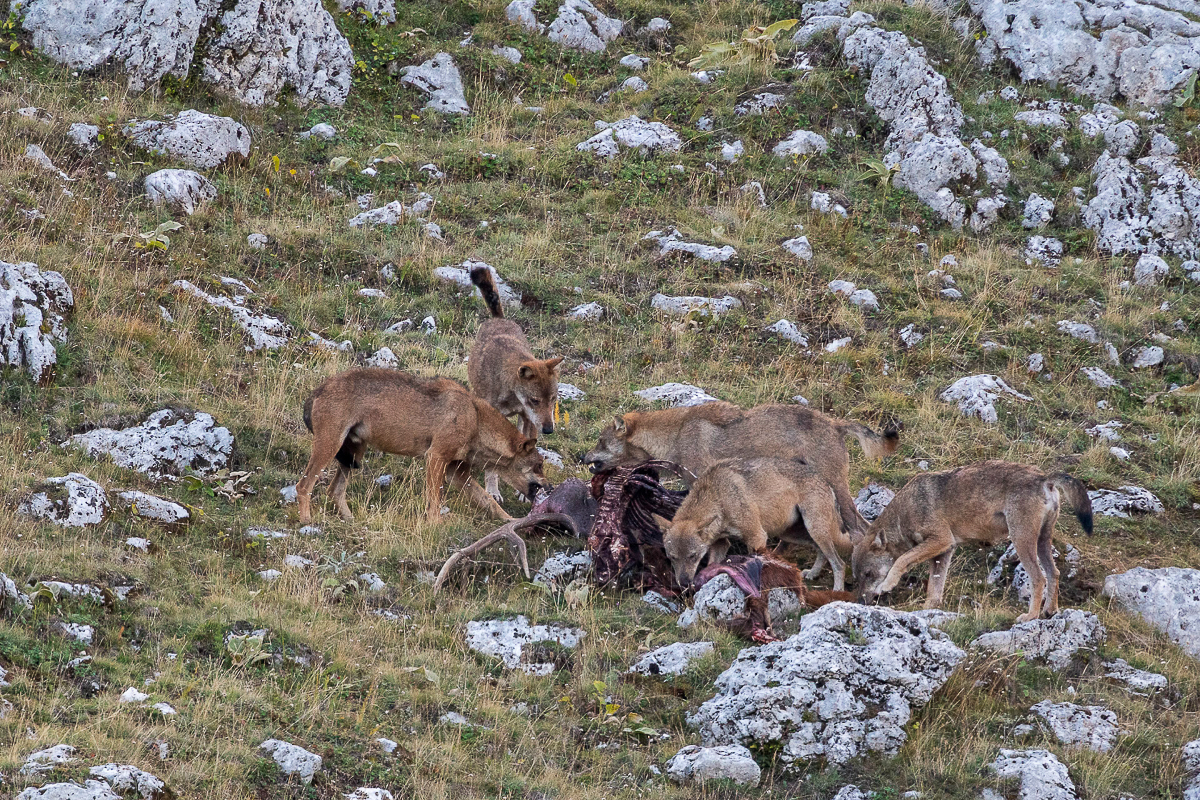
Two adult stags fight during the mating season. Fights can sometimes become bloody and one or both contenders may die. During this period, carnivorous and necrophagous animals take advantage of the presence of carcasses. In the photo on the right, a pack of wolves feeds on the carcass of a deer that died following a violent encounter.
Meat ranks only third in the Marsican bear’s annual diet, just as in other populations living in more southerly latitudes.
This may seem a paradox when you think, for example, that only one or two species of wild ungulate live in the boreal forests, whereas there may be as many as seven in southern Europe. Actually though, it’s not so surprising if you consider three factors: temperature, snow conditions and the availability of food. In northern latitudes, bears have very short summers and very long winters and they have very little time indeed to fatten up by eating mainly fruits and herbaceous plants. The hibernation period can last over six months and bears lose much more weight than do their southern counterparts. The trees in those forests do not produce nutritious energy-rich seeds, such as pine nuts, beechnuts, acorns or chestnuts. But the harsh, snowy winters debilitate the elk, making them an easy meal in the first few months after the snow melts. Its smaller size and physiological and morphological adaptations for a strictly vegetarian diet make the Marsican bear one of the brown bears most able to gain weight by feeding mainly on plants.
Brown bears are basically necrophages (in other words, they eat animals that are already dead), but they can also prey on red and roe deer, elk and even bison, albeit with less agility than wolves. It’s the opportunity that makes the bear a predator. The more a prey is vulnerable, available (present in large numbers) and accessible (non-aggressive and easy to isolate), the more likely it is to be chosen for an attack. The general rule is to avoid large, aggressive animals that could put the predator’s own life at risk. But even eating only carcasses is not such an obvious choice, because you can only benefit if you’re the only one eating them. The larger the carcass, the more likely it is to attract other competitors, but the smaller it is, the less likely it is to be found before being eaten by other scavengers. Bears have specialised in usurping carcasses killed by other predators such as wolves and lynxes, a phenomenon known as kleptoparasitism. So for bears, the best strategy is to prey on the young of a species, then to only attack the adults when they are at their weakest, or to feed on the carcasses of medium and large animals whenever possible.
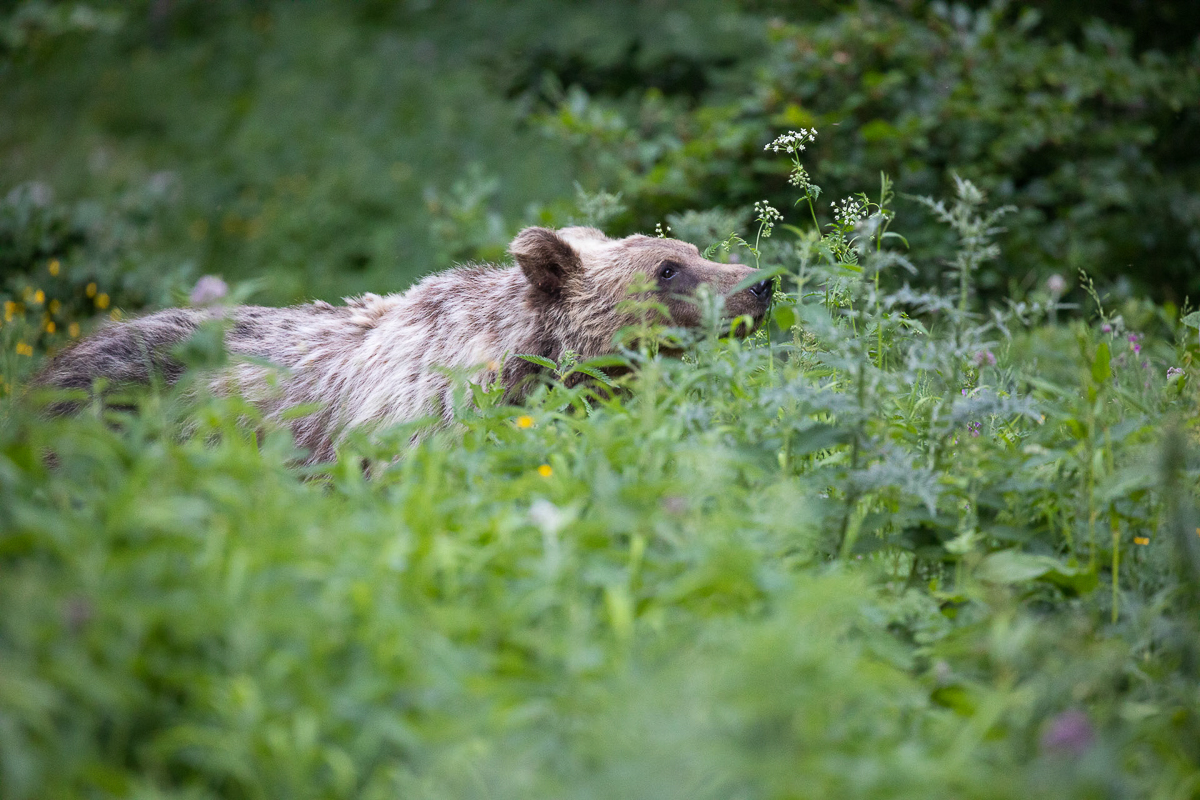
The Apennine bear is predominantly vegetarian. A bear crosses the lush vegetation of a damp, shady valley. Here it can find the umbellifers it feeds on in early summer.
The Park certainly offers a great many opportunities for bears to feed on carcasses all year around.
A study carried out in the Park s in this area between 2006 and 2010, showed that domestic livestock accounts for an average of 63% of the biomass ingested by wolves, followed by wild prey (mainly wild boar and red and roe deer). However, a targeted study carried out in winter, when it is possible to follow the wolf tracks in the snow and interpret their behaviour, found that both solitary wolves and packs feed for 73% on pre-existing carcasses, with 76% of these being the carcasses of domestic animals that have died for reasons other than predation (such as disease and malnutrition). This suggests that the great availability of domestic animal carcasses in the Park may reduce the need, attitude and behaviour of a true predator such as the wolf. Bears are certainly among the first to take advantage of this situation, obviously in summer, when there are more domestic animals, and therefore also carcasses, available at high altitudes.
Over the years we have accumulated hundreds of minutes of camera trap footage of predator and scavenger interactions on deer, horse and cow carcasses. We have observed bears, wolves and foxes feeding simultaneously on the same carcass. On other occasions, while the bears were eating, the wolves had to wait their turn a few dozen metres away, taking turns. In all cases it seems to be the bears that dictate the rules and the “change of shift”. These anecdotes confirm that maybe the competition is not so fierce and “there is something for everyone.
Elisabetta
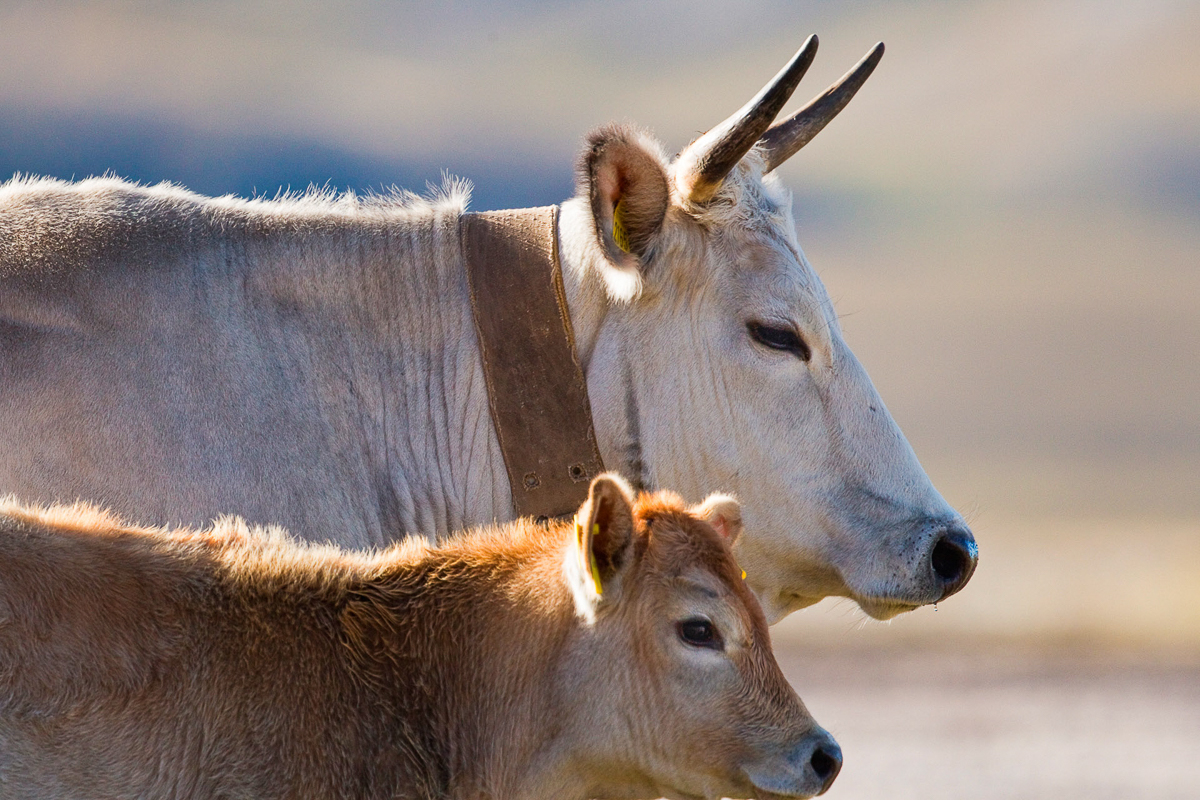
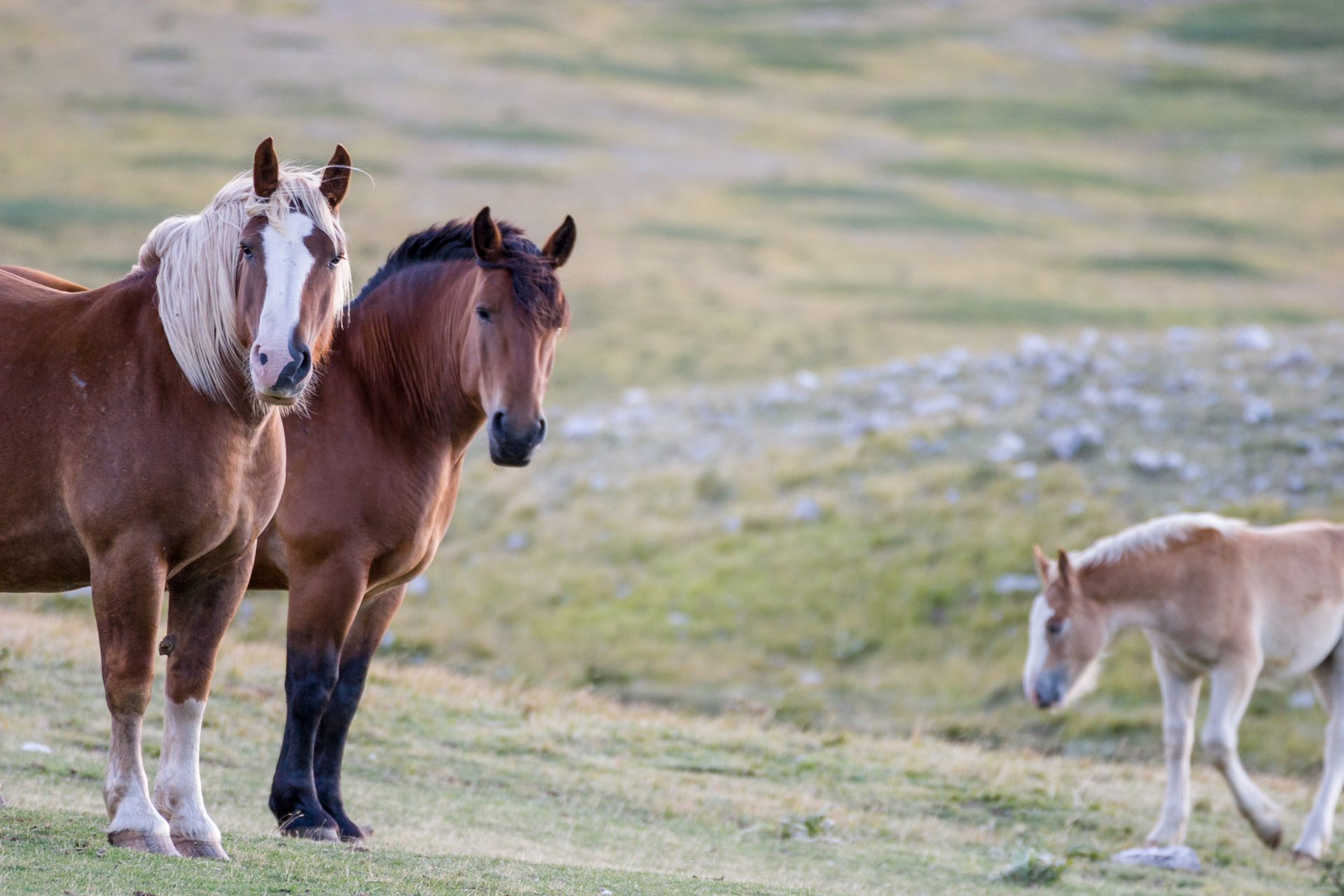
In the Apennines, livestock is frequently left in a semi-wild state, with herds of cattle and horses often remaining in the mountains for several months a year.
Domestic animals are easy prey for bears and wolves because they lack strategies against predators, unlike a deer born and raised to escape them.
This is why bears prefer attacking domestic livestock. According to compensation reports, more than half of the bear damage reported is attributable to large domestic animals, followed by poultry, orchards and crops. Compensation reports compiled over the last twenty years show that sheep and goats represent the most preyed on category, followed by cows and horses. In the case of cows and horses, more than 90% of the animals preyed on are usually only a few weeks or months old, the most vulnerable category. The high frequency of attacks on sheep and goats can be explained partly by the lack of prevention systems, partly by particular environmental conditions (such as foggy or stormy days) and partly by the simple fact of their abundance in the Park. Attacks on cows and horses, on the other hand, are due to the habit of leaving livestock grazing unattended in high altitude meadows.
A targeted study conducted between 2009 and 2010 in the Abruzzo, Lazio and Molise National Park shows that six bears consumed a total of at least 52 carcasses during the summer and autumn, corresponding to one carcass every 8-28 days for the females and one every 3-9 days for the males. The carcases were mainly of cattle and horses, followed by deer and sheep or goats. Considering an average annual active period of 244 days, this consumption could easily meet more than 50% of the bears’ basic active energy costs. Several studies show that the brown bears that eat most meat reproduce more, grow larger and live in larger populations. This is the case in coastal areas of North America, where bears have access to abundant seasonal protein resources such as salmon. The relationship would seem to be less strong in contexts similar to the Apennines. But it is also true that bears discard almost nothing of, for example, a deer. They are still physiologically carnivorous animals and can digest and assimilate 90% of the meat they eat, accumulating both protein and fat. In practice, bears gain weight more quickly by eating meat. However, bears cannot eat protein alone. The perfect recipe, the optimum way for the bears to gain weight, should contain 17% animal protein, plus fats and carbohydrates.
American bear expert David Mattson explains the importance of meat as a food source for brown bears.
The first time we saw a bear feeding on a carcass was amazing. It was 6.00 on the morning of 10 August 2008. My colleague and I had literally crawled to a vantage point about 800 metres away. The carcass appeared intact and everything seemed calm. There was only one wolf lying about 50 metres from the remains. We couldn’t interpret the situation. After an hour or so we began to see the cow’s belly move and the skin lift up. And there was a bear emerging from the cow’s abdomen with a deft about turn. As the day dawned, the bear moved away. Only then did the wolf timidly approach the carcass, but with its tail between its legs.
Elisabetta
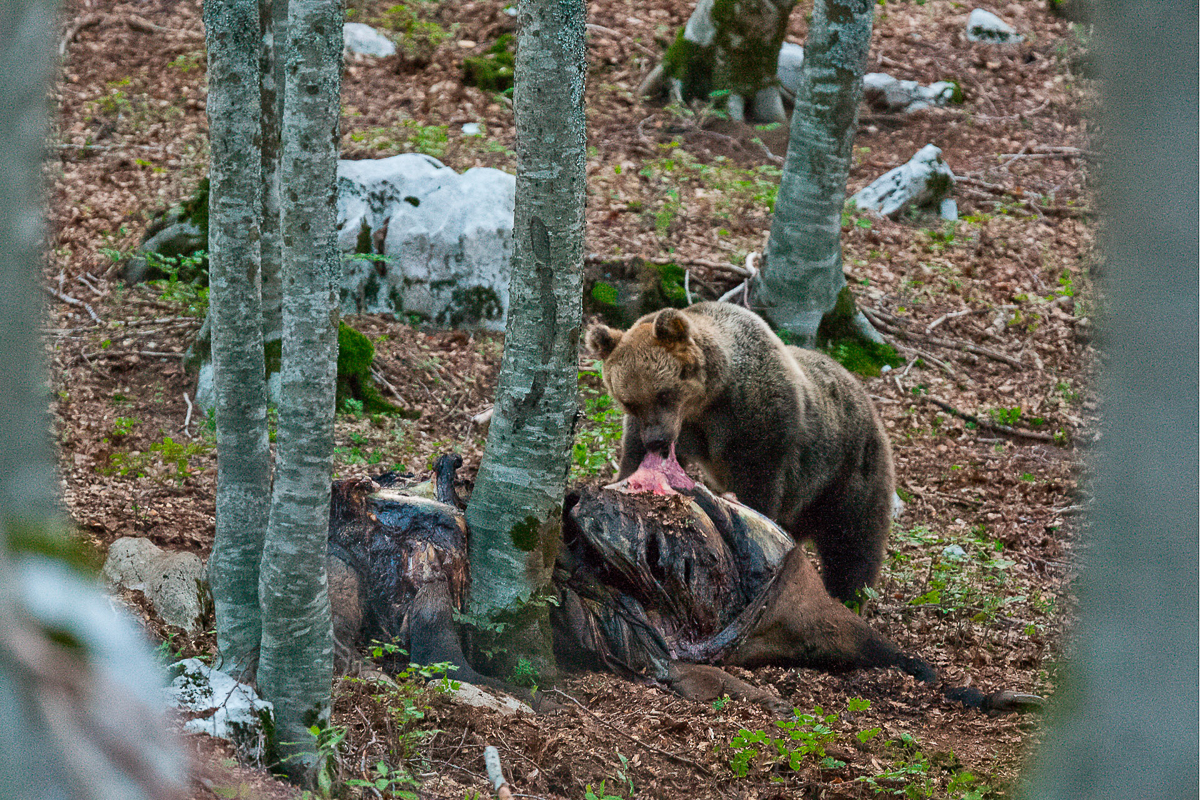
An adult Apennine bear feeds on the carcass of a mule, found in the woods. The animal assumes a dominant attitude to defend it from competitors.
Arrivare per primi ad una carcassa è sicuramente un vantaggio per qualsiasi animale.
Getting to a carcass first is certainly an advantage for any animal. Bears can eat up to 40 kg of meat per day. If they find an intact carcass, they first gut it in search of the lungs, liver and heart, the most nutritious and digestible parts. The bear never touches the contents of the stomach or intestines and rarely eats the skin. The carcasses look as though they’ve been skinned. After the viscera, the preferred morsels are the rump and the parts nearest to the hind limbs. In the case of a stag, bears do not disdain the antlers, especially if still covered in velvet, or they may feed on the bony tips, rich in calcium and minerals. As skilful usurpers, bears try to secure exclusivity by partially burying the carcass with earth, leaf litter and branches, or where possible, by dragging it into the bushes or woods where they can eat it in peace, safe from danger or competitors. Some researchers have observed that bears do not consume the carcass immediately, but may wait up to three days before eating it. This would slow down decomposition and at the same time allow the meat to mature and thus become more palatable. Other bears use a more effective strategy to avoid theft, sleeping on the carcass, or guarding it at close range.
In August 2007 we had an opportunity to reconstruct the activities of two bears around two different carcasses, thanks to the presence of satellite tracking collars. Having found the carcass of a cow weighing around 500 kg, the adult male M06 spent about ten days within two kilometres of the carcass, visiting it at least twice a day, almost always at night, and staying there from a few to eight consecutive hours. During this time, the bear also ate apples and pears and drank a lot to aid digestion, visiting a drinking trough about a kilometre away several times. A well-balanced textbook diet. When M06 was not present, at least two other bears and several wolves were observed feeding on the cow during the day. During the same summer a known female, F07, discovered an intact male deer carcass. She ate a whole deer weighing almost 200 kilograms in just six days. During this period, the bear monopolised the carcass by both day and night, staying near the remains for up to 13 consecutive hours. The bear practically slept in the vicinity of the remains, as documented by the discovery of several beds and droppings, only leaving to drink from a spring and eat beechnuts.
Anecdotal evidence suggests that in the Park it is rare for one bear alone to eat a cow or deer carcass. An average of at least three bears have been observed feeding on the same carcass on the same day, rarely together, as well as wolves, foxes and griffon vultures. The links between predators are very complex. Researchers have shown that bears generally prevail over other predators such as wolves, even when these are in groups, while other predators act as facilitators for the bear, in other words, they provide them with free carcasses. It is surprising how even the simple act of eating or preying on another animal can affect the lives of numerous other animals, including birds, reptiles, amphibians and insects… even plants. But bears can be very aggressive towards other scavengers, even when these are other bears. Females with cubs tend to avoid carcasses if they can, as the presence of males in the vicinity can compromise the safety of their young. In Yellowstone National Park, one of the main causes of cub death is the simultaneous presence of males and females on the same carcass.
A dead cow abandoned in a clearing can be an irresistible attraction for wolves and bears, especially in the autumn. In the sequence, at twilight a pack of wolves is driven away from the carcass by a female bear accompanied by her yearling cub.
The great availability of domestic animal carcasses and their extensive use by bears confirm the importance of this resource in the diet of this species in the Apennines. What to do with livestock carcasses has always been a problem in the mountains, where it is often difficult or impossible to reach them with appropriate means of transport and tools to dispose of them. On one hand, these carcasses represent a very important source of nutrition. On the other, through a mechanism of food habituation, they may expose bears to increased risks of poaching, conflict, accidents and disease transmission.
For bears, getting used to eating livestock carcasses may be risky. In the Apennines, there have been many cases of bears dying after eating a poisoned sheep, or after being hit by a car while making their way to heaps of slaughter waste left by the roadside.

